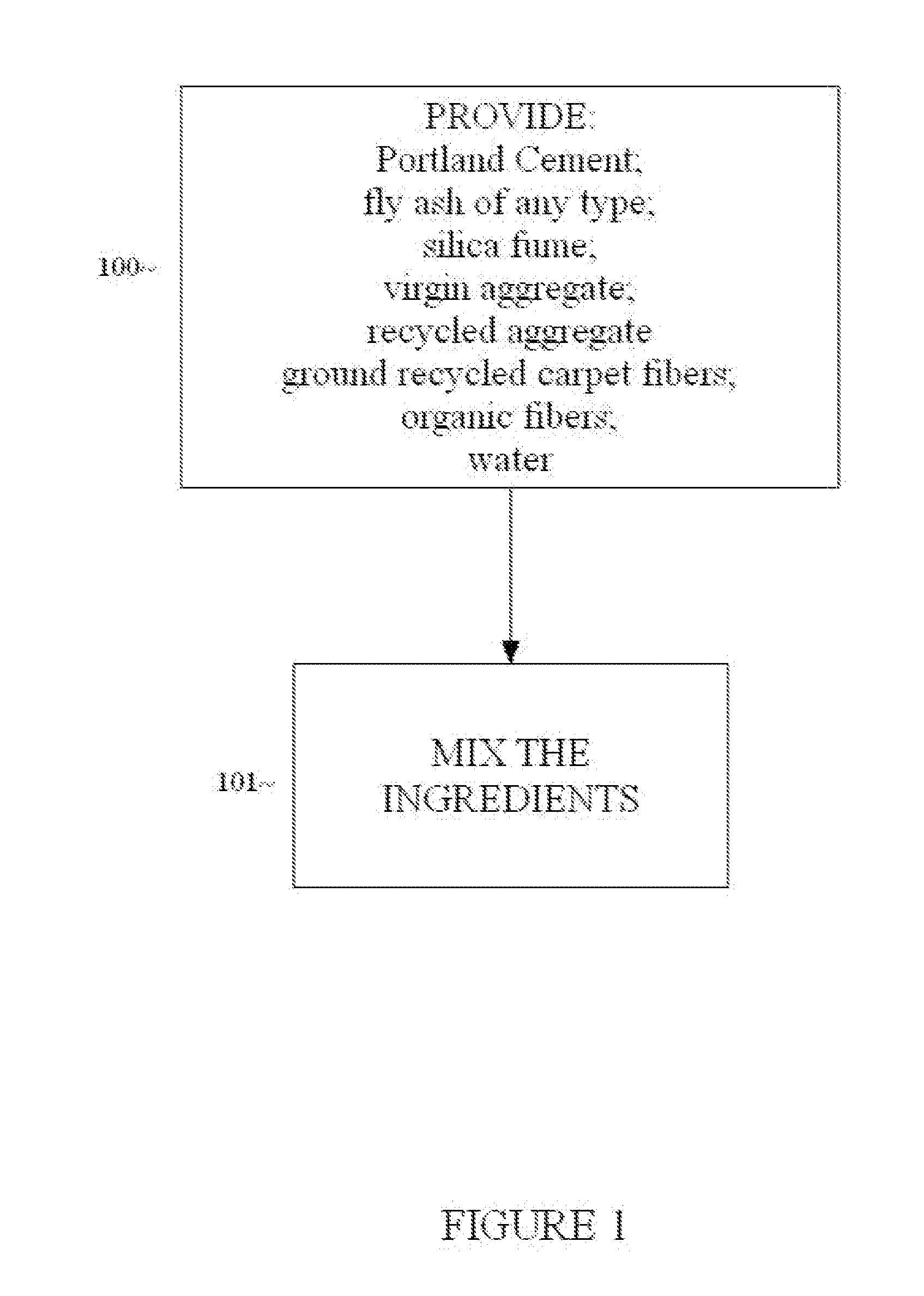Low Embodied Energy Concrete Mixture
- Summary
- Abstract
- Description
- Claims
- Application Information
AI Technical Summary
Benefits of technology
Problems solved by technology
Method used
Image
Examples
second embodiment
[0026]In a second embodiment, an extremely low energy content, cementitious mixture can be created using 0% to 2% Portland cement, 3% to 4% GGBFS, 6% to 8% fly ash of any type, 2% to 4% silica fume as measured as a percent of the amount of Portland cement utilized by weight, 2500 to 3600 per cubic yard pounds of recycled concrete, bricks or other recycled building materials per cubic yard of cementitious mixture created, 2.5 to 3.5 pounds per cubic yard of recycled carpet fibers further comprising nanoparticles, 5.5 to 6.5 pounds per cubic yard of rice hull waste fibers, and a 30% to 65% ratio (by weight) of water to the combined weight of Portland cement and fly ash used.
third embodiment
[0027]In a third embodiment, a low energy content, cementitious mixture, having a compressive strength greater than 8,000 p.s.i. can be created using approximately 5.5% Portland cement, approximately 8% fly ash of any type, approximately 15% silica fume as measured as a percent of the amount of Portland cement utilized by weight, 2500 to 3600 pounds per cubic yard of recycled concrete, bricks or other recycled building materials per cubic yard of cementitious mixture created, 2.5 to 3.5 pounds per cubic yard of recycled carpet fibers further comprising nanoparticles, 5.5 to 6.5 pounds per cubic yard of rice hull waste fibers, 1.25% to 1.75% high range water reducer measured as a percent of the amount of Portland cement utilized by weight, and a 25% to 65% ratio (by weight) of water to the combined weight of Portland cement and fly ash used.
fourth embodiment
[0028]In a fourth embodiment, a low energy content, cementitious mixture, having high flowability properties can be created using 4.5% to 5.5% Portland cement, 6% to 8% fly ash of any type, 2% to 4% silica fume as measured as a percent of the amount of Portland cement utilized by weight, 2500 to 3600 pounds per cubic yard of recycled concrete, bricks or other recycled building materials per cubic yard of cementitious mixture created, 2.5 to 3.5 pounds per cubic yard of recycled carpet fibers further comprising nanoparticles, 5.5 to 6.5 pounds per cubic yard of rice hull waste fibers, 1.25% to 1.75% high range water reducer measured as a percent of the amount of Portland cement utilized by weight, and a 20% to 65% ratio (by weight) of water to the combined weight of Portland cement and fly ash used.
Different Applications and Use of Post-Industrial Waste Like Materials
[0029]Several U.S. patents have described the use of some of the aforementioned post-industrial waste in the developme...
PUM
| Property | Measurement | Unit |
|---|---|---|
| Fraction | aaaaa | aaaaa |
| Fraction | aaaaa | aaaaa |
| Fraction | aaaaa | aaaaa |
Abstract
Description
Claims
Application Information
 Login to View More
Login to View More - R&D
- Intellectual Property
- Life Sciences
- Materials
- Tech Scout
- Unparalleled Data Quality
- Higher Quality Content
- 60% Fewer Hallucinations
Browse by: Latest US Patents, China's latest patents, Technical Efficacy Thesaurus, Application Domain, Technology Topic, Popular Technical Reports.
© 2025 PatSnap. All rights reserved.Legal|Privacy policy|Modern Slavery Act Transparency Statement|Sitemap|About US| Contact US: help@patsnap.com

